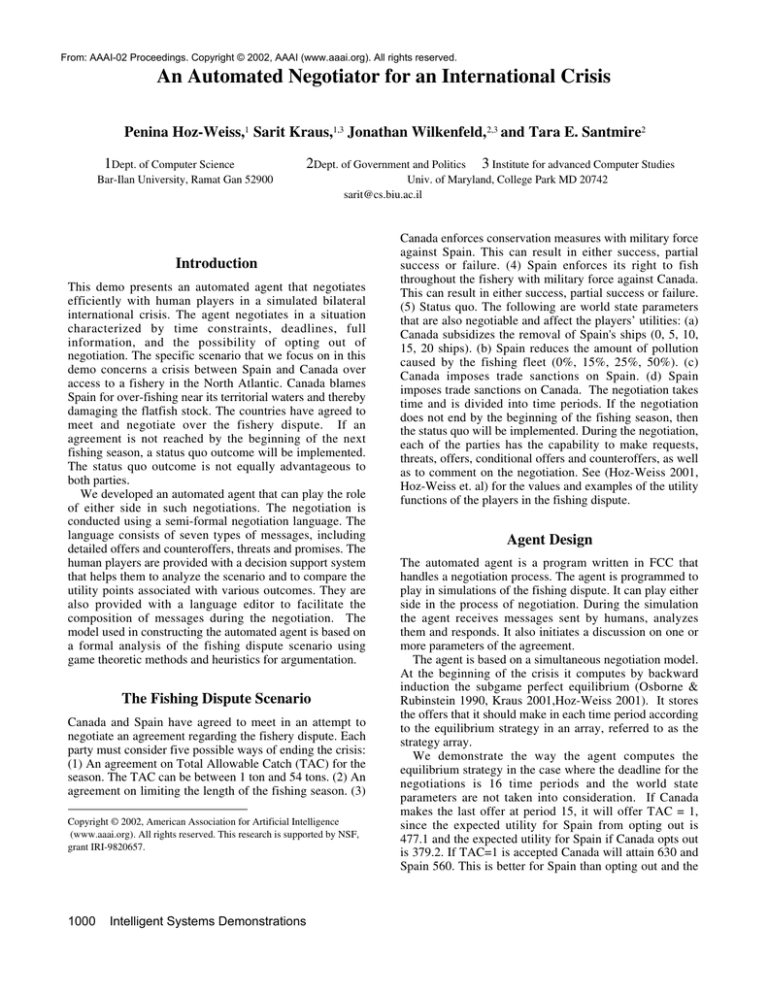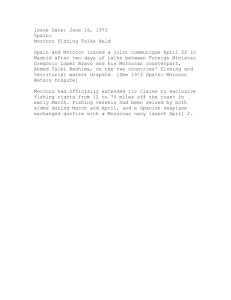
From: AAAI-02 Proceedings. Copyright © 2002, AAAI (www.aaai.org). All rights reserved.
An Automated Negotiator for an International Crisis
Penina Hoz-Weiss,1 Sarit Kraus,1,3 Jonathan Wilkenfeld,2,3 and Tara E. Santmire2
1Dept. of Computer Science
Bar-Ilan University, Ramat Gan 52900
2Dept. of Government and Politics
3 Institute for advanced Computer Studies
Univ. of Maryland, College Park MD 20742
sarit@cs.biu.ac.il
Introduction
This demo presents an automated agent that negotiates
efficiently with human players in a simulated bilateral
international crisis. The agent negotiates in a situation
characterized by time constraints, deadlines, full
information, and the possibility of opting out of
negotiation. The specific scenario that we focus on in this
demo concerns a crisis between Spain and Canada over
access to a fishery in the North Atlantic. Canada blames
Spain for over-fishing near its territorial waters and thereby
damaging the flatfish stock. The countries have agreed to
meet and negotiate over the fishery dispute. If an
agreement is not reached by the beginning of the next
fishing season, a status quo outcome will be implemented.
The status quo outcome is not equally advantageous to
both parties.
We developed an automated agent that can play the role
of either side in such negotiations. The negotiation is
conducted using a semi-formal negotiation language. The
language consists of seven types of messages, including
detailed offers and counteroffers, threats and promises. The
human players are provided with a decision support system
that helps them to analyze the scenario and to compare the
utility points associated with various outcomes. They are
also provided with a language editor to facilitate the
composition of messages during the negotiation. The
model used in constructing the automated agent is based on
a formal analysis of the fishing dispute scenario using
game theoretic methods and heuristics for argumentation.
The Fishing Dispute Scenario
Canada and Spain have agreed to meet in an attempt to
negotiate an agreement regarding the fishery dispute. Each
party must consider five possible ways of ending the crisis:
(1) An agreement on Total Allowable Catch (TAC) for the
season. The TAC can be between 1 ton and 54 tons. (2) An
agreement on limiting the length of the fishing season. (3)
Copyright © 2002, American Association for Artificial Intelligence
(www.aaai.org). All rights reserved. This research is supported by NSF,
grant IRI-9820657.
1000
Intelligent Systems Demonstrations
Canada enforces conservation measures with military force
against Spain. This can result in either success, partial
success or failure. (4) Spain enforces its right to fish
throughout the fishery with military force against Canada.
This can result in either success, partial success or failure.
(5) Status quo. The following are world state parameters
that are also negotiable and affect the players’ utilities: (a)
Canada subsidizes the removal of Spain's ships (0, 5, 10,
15, 20 ships). (b) Spain reduces the amount of pollution
caused by the fishing fleet (0%, 15%, 25%, 50%). (c)
Canada imposes trade sanctions on Spain. (d) Spain
imposes trade sanctions on Canada. The negotiation takes
time and is divided into time periods. If the negotiation
does not end by the beginning of the fishing season, then
the status quo will be implemented. During the negotiation,
each of the parties has the capability to make requests,
threats, offers, conditional offers and counteroffers, as well
as to comment on the negotiation. See (Hoz-Weiss 2001,
Hoz-Weiss et. al) for the values and examples of the utility
functions of the players in the fishing dispute.
Agent Design
The automated agent is a program written in FCC that
handles a negotiation process. The agent is programmed to
play in simulations of the fishing dispute. It can play either
side in the process of negotiation. During the simulation
the agent receives messages sent by humans, analyzes
them and responds. It also initiates a discussion on one or
more parameters of the agreement.
The agent is based on a simultaneous negotiation model.
At the beginning of the crisis it computes by backward
induction the subgame perfect equilibrium (Osborne &
Rubinstein 1990, Kraus 2001,Hoz-Weiss 2001). It stores
the offers that it should make in each time period according
to the equilibrium strategy in an array, referred to as the
strategy array.
We demonstrate the way the agent computes the
equilibrium strategy in the case where the deadline for the
negotiations is 16 time periods and the world state
parameters are not taken into consideration. If Canada
makes the last offer at period 15, it will offer TAC = 1,
since the expected utility for Spain from opting out is
477.1 and the expected utility for Spain if Canada opts out
is 379.2. If TAC=1 is accepted Canada will attain 630 and
Spain 560. This is better for Spain than opting out and the
best possible outcome for Canada. If Spain makes the last
offer, it will offer TAC = 39 since Spain would attain 940
and Canada 440, and the expected utility for Canada from
opting out is 438.8. Thus, TAC=39 is better for Canada
than opting out and the best possible outcome for Spain.
When going backward to t= 14 each country that will make
an offer has to offer an agreement that will provide the
other party a utility which is higher than the expected
utility from opting out and higher than the expected utility
in period 15. Both Canada and Spain, if they make an offer
at t = 14, will offer TAC = 21. Continuing the backward
induction, at the first time period the agreement that will be
offered by a country will be TAC = 34 which gives Spain a
utility of 750 and Canada a utility of 535. The other
country will accept the agreement.
If the agent was playing against a rational opponent,
who has the ability to identify the subgame perfect
equilibrium, this would be sufficient. In particular when
one version of the agent plays against another version, the
agreement is reached in the first time period in the array.
However, humans do not necessarily follow equilibrium
strategies, and when the automated agent follows its
equilibrium strategy the human negotiators become
frustrated and often the negotiation ends with no
agreement. Therefore, the formal theory is not enough and
we added heuristics and argumentation to complete the
formal model and make the agent an effective negotiator
with humans.
There are two main activities that the agent performs
during the negotiations: (a) Responding to incoming
messages, and sending counteroffers that serve the interests
of the automated agent: The specific message depends on
the incoming messages, the strategy array, the world state
and the agent’s parameters that are specified below. The
agent maintains the state of the world during the
negotiation. (b) Sending messages regarding issues that
have not yet been discussed: Every three minutes the agent
checks which parameter was not negotiated recently and
then it sends a message regarding that parameter. The
specific heuristics can be found in (Hoz-Weiss 2001).
As part of the heuristics we used there is a set of
parameters that influences the agent's behavior. These
parameters are instantiated before the beginning of the
negotiations: (i) A parameter that indicates whether the
agent sends the first message in the negotiation or waits for
the opponent to make the first offer. (ii) A parameter that
determines if the agent will use the full offer message or
will use partial offers to negotiate each issue separately.
(iii) The number of negotiation units (tons of fish in the
fishing dispute) the agent will increase or decrease its offer
by. (iv) The agent agrees to an agreement that yields a
utility that is lower than the desired utility by at most the
number of points specified by this parameter.
The agent is sensitive to the risk level of its human
opponent and will change its view of the human’s utility
function accordingly. The agent begins with the
assumption that its opponent is risk neutral. We use a
heuristic method to decide whether to change the
estimation of the risk attitude of the opponent. When the
agent decides that its opponent is risk prone, it changes the
opponent’s utility function. This leads the agent to a
recalculation of the strategy array.
Experiments
In order to evaluate the agent's performance in negotiation
situations and to compare it to the performance of humans,
we conducted simulations with Computer Science students
at Bar Ilan University. The students were introduced to the
Generalized Decision Support System (GDSS) for the
Fishing Dispute simulation, by which they could evaluate
different outcomes in terms of utility point values. A total
of 45 simulations were run: 15 simulations were human
against human, and 30 simulations were human against the
agent. In 14 simulations the agent played Spain and in 16
simulations the agent played Canada (Hoz-Weiss 2001).
Comparing the results of the humans to those of the agents
for those simulations that ended with an agreement, the
agent plays Spain's role significantly better than the human
does (agent’s average utility: 845; humans’ average utility:
723; t=-5.957, p<0.01) and the role of Canada just as well
as a human (agent’s average utility: 607; humans’ average
utility: 612). When looking at the results that include all
the outcomes, again, the agent playing Spain played
significantly better than the human playing Spain (t=-2.51,
p<0.05). The results for Canada did not show a significant
difference between the agent and human players.
In addition, the average sum of utility points in simulations
where agreements were reached with only humans was
1336 and the average sum of the simulations where an
agent was involved was 1439. We conclude that when an
agent participates in a negotiation the sum of the utilities
was significantly higher than when two humans played (
t=-4.916, p<0.01).
References
P. Hoz-Weiss. An Automated Negotiator for a Fishing
Dispute, Master thesis, Bar-Ilan Univ., Ramat-Gan 2001.
P. Hoz-Weiss, S. Kraus, J. Wilkenfeld and T. E. Santmire.
An Automated Agent for Bilateral Negotiations with
Humans, in M. Huget editor, Communication in MAS
Springer-Verlag. (To appear).
S. Kraus, Strategic Negotiation in Multiagent
Environments. MIT Press, 2001.
Osborne, M. J. and A. Rubinstein 1990. Bargaining and
Markets, Academic Press.
Intelligent Systems Demonstrations
1001




